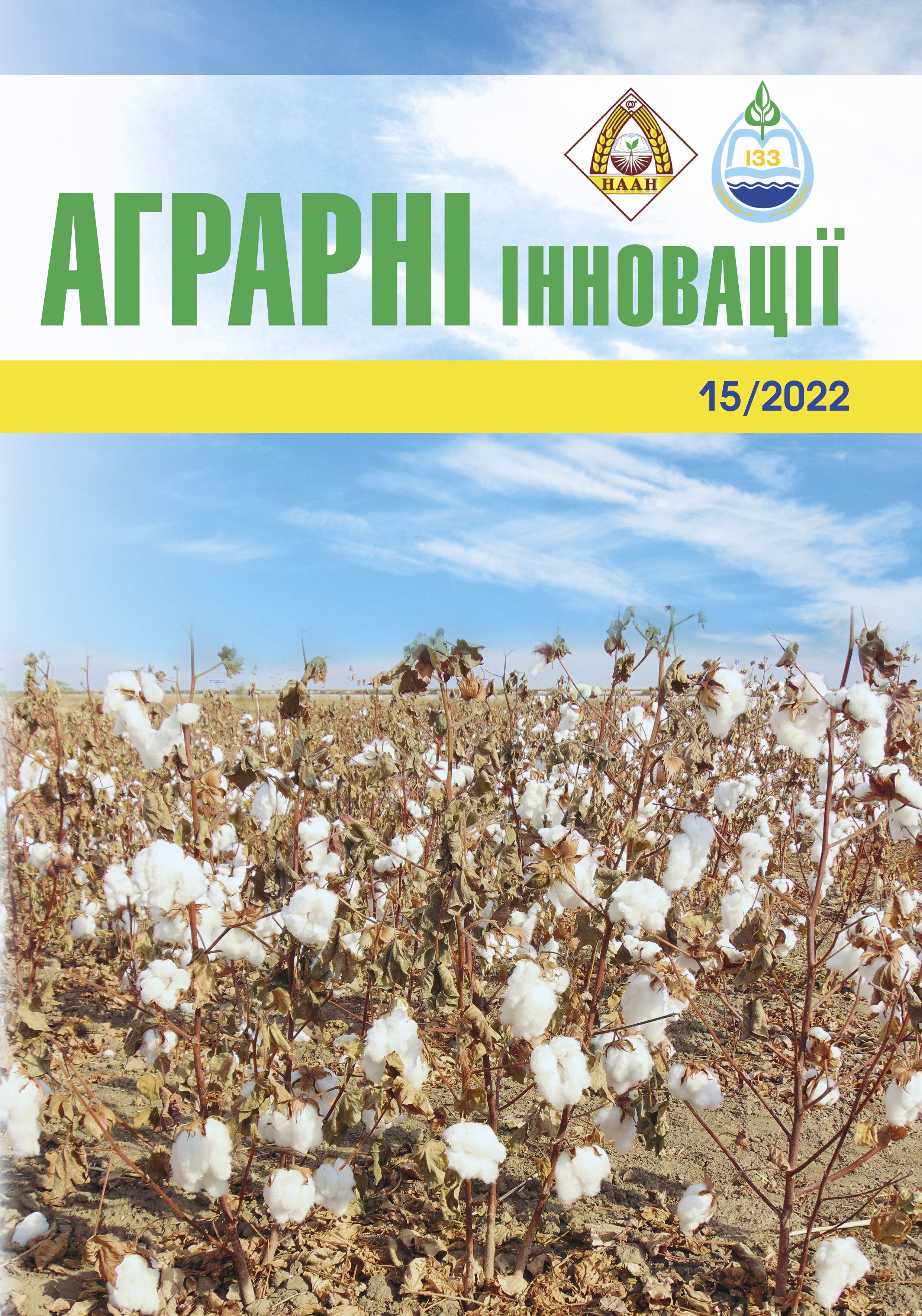he value of some donors of resistance to leaf rust for breeding bead winter wheat in the conditions of southern Ukraine
Abstract
Purpose. To determine the breeding value of various genetic sources of resistance of bread winter wheat to leaf rust (Puccinia Triticina) with acceptable donor properties. Methods. Field, comparison, generalization, mathematical statistics, hybridological analysis. Results. On the material of hybrid combinations from simple and triple crossings, Donor effect of genetic structure Lr 34 was researched depending on the crossing scheme. It was established that F4 genotypes from simple crosses, where at least one of the parents has this genetic construction, show a slightly higher resistance to leaf rust compared to the sort–standard Antonivka, which does not contain Lr 34 in its genotype. The highest rate of resistance, significantly exceeding the standard, was found in line L.17018, which is the inheritor of the Lr 34 gene from both parents Dalnytska and Sluzhnytsia. In selection lines of the final stage of selection F12 from simple crosses, the average score of resistance to leaf rust exceeded the standard and the average score of selection numbers F4, with a slight variation of this trait. The effect of saturation in triple crossing combinations slightly increased the average score of resistance to brown rust of selection lines L.18016 and L.18716 F4 and F12 in relation to the standard variety Antonivka, but in general, it did not dramatically affect the strengthening of resistance to brown rust itself. Among the lines with the genetic structure Lr 34, the most resistant to brown rust were L.17018 among simple crosses and L.18016 among triple crosses with the effect of saturation with this trait. The effect of saturation in triple crossing combinations slightly increased the average score of resistance to leaf rust of selection lines L.18016 and L.18716 F4 and F12 in relation to the sort–standard Antonivka, but in general, it did not dramatically affect the strengthening of resistance to leaf rust itself. Among the lines with the genetic structure Lr 34, the most resistant to leaf rust were L.17018 among simple crosses and L.18016 among triple crosses with the effect of saturation with this trait. Breeding lines that have Lr genes in their pedigree from parents from Western Europe have a significantly higher average score of resistance to leaf rust in relation to the standard at all stages of the breeding process, and the highest effect of saturation with these genes was noted at the final breeding stage. Selection lines L.21919 in simple crosses and L.16718 in triple crosses turned out to be the best genetic sources. Conclusions. Breeding lines, which were obtained from parents with genetic construction Lr 34, are characterized by increased resistance to leaf rust in relation to the standard. This resistance appears in lines from both simple and triple crossings and is characterized by a higher resistance score as well as phenotypic and genotypic stability in F12 hybrid combinations. The effect of saturation in triple combinations of crosses with the sources of the genetic construction Lr 34 did not fundamentally affect the enhancement of resistance to leaf rust. Selection lines – descendants of carriers of Lr genes from Western European sorts significantly exceed the sort–standard in terms of the average score of resistance to brown rust, regardless of crossing schemes. In the course of research, a number of promising lines (L.17018, L.18016, L21919 and L.16718) were identified among the studied crossbreeding combinations, which can serve as genetic sources of signs of resistance of bread winter wheat to leaf rust.
References
2. Трибель С.О. Стійкі сорти: проблеми і перспективи. Карантин і захист рослин. 2005. № 4. С. 3–5.
3. Лісовий М.П. Історичні етапи розвитку досліджень генетики стійкості рослин щодо збудників хвороб. Міжвідомчий тематичний науковий збірник. Київ, 2001. Вип. 47. С. 3–25.
4. Бабаянц Л.Т. Устойчивость сортов пшеницы к бурой листовой ржавчине и мучнистой росе в условиях юго-запада Украины и Молдавии. Научно–технический бюллетень ВСГИ. Одесса, 1976. Вып. 29. С. 53–57.
5. Jackson, H. S., Mains. J, E. B. Aеcial stage of the orange leaf rust of wheat Puccinia triticina Erikss. Agric. Res.1921. № 22. P. 151.
6. Марков, І. Л. Волога проти пшениці: хвороби в умовах зрошення. Агросектор. 2008. № 2 (27). С. 24–25.
7. Дерменко О.П., Панченко Ю.С., Гаврилюк Л.Л. Небезпечна хвороба пшениці озимої. Бура листкова іржа (Puccinia recondita Rob. ex Desm. f. sp.tritici): поширення і розвиток в Лісостепу України. Карантин і захист рослин. 2012. № 11. С. 4–7.
8. Belan I.A. Using of alien genetic material in the breeding of spring bread wheat. Abstracts of the 15th International EWAC Conference. 7–11 November 2011. Novi Sad, Serbia. 2011. P. 46.
9. Методика проведення експертизи сортів рослин групи зернових, круп’яних та зернобобових на придатність до поширення в Україні. Затверджено Наказом Міністерства аграрної політики та продовольства України 12.12.2016 р. № 540.
10. Карелов А. В., Пирко Я. В, Козуб Н. А. та ін. Идентификация аллельного состояния гена устойчивости к бурой ржавчине Lr 34 у сортов озимой мягкой пшеницы украинской селекции. Цитология и генетика. 2011. № 5 С. 3–10.
11. Литвиненко М.А. Алєксєєнко Є.В. Перспективи селекційного використання зразків пшениці західноєвропейського сортотипу – носіїв транслокації 1BL/1RS та локусу Lr34. Збірник наукових праць СГІ – НЦНС. 2015. Вип.26 (66). С. 21–32.
12. Бабаянц О.В., Бабаянц Л.Т. Основы селекции и методология оценок устойчивости пшеницы к возбудителям болезней. Одесса : ВМВ, 2014. 401с.






